Characterization of Transparent Fluorapatite Ceramics Fabricated by Spark Plasma Sintering
Abstract
:1. Introduction
2. Materials and Methods
2.1. Sample Preparation
2.2. Optical, Chemical Content, and Microstructure Characterization
2.3. Physical Properties
3. Results and Discussion
4. Conclusions
Author Contributions
Funding
Institutional Review Board Statement
Informed Consent Statement
Data Availability Statement
Conflicts of Interest
References
- Koutsopoulos, S. Synthesis and characterization of hydroxyapatite crystals: A review study on the analytical methods. J. Biomed. Mater. Res. 2002, 62, 600–612. [Google Scholar] [CrossRef] [PubMed]
- Blitterswijk, C.A.; Hesseling, S.C.; Grote, J.J.; Koerten, H.K.; Groot, K. The biocompatibility of hydroxyapatite ceramic: A study of retrieved human middle ear implants. J. Biomed. Mater. Res. 1990, 24, 433–453. [Google Scholar] [CrossRef] [PubMed]
- Kotobuki, N.; Ioku, K.; Kawagoe, D.; Fujimori, H.; Goto, S.; Ohgushi, H. Observation of osteogenic differentiation cascade of living mesenchymal stem cells on transparent hydroxyapatite ceramics. Biomaterials 2005, 26, 779–785. [Google Scholar] [CrossRef] [PubMed]
- Kawagoe, D.; Koga, Y.; Ishida, E.H.; Kotobuki, N.; Ohgushi, H.; Ioku, K. Preparation of transparent hydroxyapatite ceramics by spark plasma sintering and cell culture test. Phosphorus Res. Bull. 2006, 20, 119–128. [Google Scholar] [CrossRef] [Green Version]
- Takikawa, K.; Akao, M. Fabrication of transparent hydroxyapatite and application to bone marrow derived cell/hydroxyapatite interaction observation in vivo. J. Mater. Sci. Mater. Med. 1996, 7, 439–445. [Google Scholar] [CrossRef]
- Tredwin, C.J.; Young, A.M.; Abou Neel, E.A.; Georgiou, G.; Knowles, J.C. Hydroxyapatite, fluor-hydroxyapatite and fluorapatite produced via the sol–gel method: Dissolution behaviour and biological properties after crystallisation. J. Mater. Sci. Mater. Med. 2014, 25, 47–53. [Google Scholar] [CrossRef] [Green Version]
- Karimi, M.; Jodaei, A.; Sadeghinik, A.; Ramsheha, M.R.; Hafshejani, T.M.; Shamsi, M.; Orand, F.; Lotfi, F. Deep eutectic choline chloride-calcium chloride as all-in-one system for sustainable and one-step synthesis of bioactive fluorapatite nanoparticles. J. Fluor. Chem. 2017, 204, 76–83. [Google Scholar] [CrossRef]
- Pajor, K.; Pajchel, L.; Kolmas, J. Hydroxyapatite and fluorapatite in conservative dentistry and oral implantology—A review. Materials 2019, 12, 2683. [Google Scholar] [CrossRef] [Green Version]
- Guyot, Y.; Canibano, H.; Goutaudier, C.; Novoselov, A.; Yoshikawa, A.; Fukuda, T.; Boulon, G. Yb3+-doped Gd3Ga5O12 garnet single crystals grown by the micro-pulling down technique for laser application. Part 2: Concentration quenching analysis and laser optimization. Opt. Mater. 2006, 28, 1–8. [Google Scholar] [CrossRef]
- DeLoach, L.D.; Payne, S.A.; Smith, L.K.; Kway, W.L.; Krupke, W.F. Laser and spectroscopic properties of Sr5(PO4)3F:Yb. J. Opt. Soc. Am. B. 1994, 11, 269–276. [Google Scholar] [CrossRef]
- Brenier, A. A new evaluation of Yb3+-doped crystals for laser applications. J. Lumin. 2001, 92, 199–204. [Google Scholar] [CrossRef]
- Schaffers, K.I.; Tassano, J.B.; Bayramian, A.B.; Morris, R.C. Growth of Yb: S-FAP [Yb3+:Sr5(PO4)3F] crystals for the Mercury laser. J. Cryst. Growth 2003, 253, 297–306. [Google Scholar] [CrossRef]
- Erlandson, A.C.; Aceves, S.M.; Bayramian, A.J.; Bullington, A.L.; Beach, R.J.; Boley, C.D.; Caird, J.A.; Deri, R.J.; Dunne, A.M.; Flowers, D.L.; et al. Comparison of Nd:phosphate glass, Yb:YAG and Yb:S-FAP laser beamlines for laser inertial fusion energy (LIFE). Opt. Mater. Express 2011, 1, 1341–1352. [Google Scholar] [CrossRef]
- Mason, P.; Divoký, M.; Ertel, K.; Pilař, J.; Butcher, T.; Hanuš, M.; Banerjee, S.; Phillips, J.; Smith, J.; De Vido, M.; et al. Kilowatt average power 100 J-level diode pumped solid state laser. Optica 2017, 4, 438–439. [Google Scholar] [CrossRef]
- Divoký, M.; Pilař, J.; Hanuš, M.; Navrátil, P.; Denk, O.; Severová, P.; Mason, P.; Butcher, T.; Banerjee, S.; De Vido, M.; et al. 150 J DPSSL operating at 1.5 kW level. Opt. Lett. 2021, 46, 5771–5773. [Google Scholar] [CrossRef]
- Apetz, R.; van Bruggen, M.P.B. Transparent alumina: A light-scattering model. J. Am. Ceram. Soc. 2003, 86, 480–486. [Google Scholar] [CrossRef]
- Tan, N.; Kou, Z.; Ding, Y.; Leng, Y.; Liu, C.; He, D. Novel substantial reductions in sintering temperatures for preparation of transparent hydroxyapatite bioceramics under ultrahigh pressure. Scripta Mater. 2011, 65, 819–822. [Google Scholar] [CrossRef]
- Uematsu, K.; Takagi, M.; Honda, T.; Uchida, N.; Saito, K. Transparent hydroxyapatite prepared by hot isostatic pressing of filter cake. J. Am. Ceram. Soc. 1989, 72, 1476–1478. [Google Scholar] [CrossRef]
- Wang, J.; Shaw, L.L. Transparent nanocrystalline hydroxyapatite by pressure-assisted sintering. Scripta Mater. 2010, 63, 593–596. [Google Scholar] [CrossRef]
- Eriksson, M.; Liu, Y.; Hu, J.; Gao, L.; Nygren, M.; Shen, Z. Transparent hydroxyapatite ceramics with nanograin structure prepared by high pressure spark plasma sintering at the minimized sintering temperature. J. Eur. Ceram. Soc. 2011, 31, 1533–1540. [Google Scholar] [CrossRef]
- Liu, Y.; Shen, Z. Dehydroxylation of hydroxyapatite in dense bulk ceramics sintered by spark plasma sintering. J. Eur. Ceram. Soc. 2012, 32, 2691–2696. [Google Scholar] [CrossRef]
- Kim, B.N.; Prajatelistia, E.; Han, Y.H.; Son, H.W.; Sakka, Y.; Kim, S. Transparent hydroxyapatite ceramics consolidated by spark plasma sintering. Scripta Mater. 2013, 69, 366–369. [Google Scholar] [CrossRef]
- Yun, J.; Son, H.; Prajatelistia, E.; Han, Y.H.; Kim, S.; Kim, B.N. Characterisation of transparent hydroxyapatite nanoceramics prepared by spark plasma sintering. Adv. Appl. Ceram. 2014, 113, 67–72. [Google Scholar] [CrossRef]
- Watanabe, Y.; Ikoma, T.; Monkawa, A.; Suetsugu, Y.; Yamada, H.; Tanaka, J.; Moriyoshi, Y. Fabrication of transparent hydroxyapatite sintered body with high crystal orientation by pulse electric current sintering. J. Am. Ceram. Soc. 2005, 88, 243–245. [Google Scholar] [CrossRef]
- Li, Z.; Thompson, B.C.; Dong, Z.; Khor, K.A. Optical and biological properties of transparent nanocrystalline hydroxyapatite obtained through spark plasma sintering. Mater. Sci. Eng. C 2016, 69, 956–966. [Google Scholar] [CrossRef] [PubMed]
- Kawagoe, D.; Koga, Y.; Yamasaki, N.; Fujimori, H.; Goto, S.; Ioku, K. Effect of hydrothermal treatment of preparation of transparent apatite ceramics by spark plasma sintering. Phosphorus Res. Bull. 2004, 17, 240–245. [Google Scholar] [CrossRef] [Green Version]
- Kim, B.N.; Horiuchi, N.; Dash, A.; Kim, Y.W.; Morita, K.; Yoshida, H.; Li, J.G.; Sakka, Y. Spark plasma sintering of highly transparent hydroxyapatite ceramics. J. Jpn. Soc. Powder Metall. 2017, 64, 547–551. [Google Scholar] [CrossRef] [Green Version]
- Furuse, H.; Horiuchi, N.; Kim, B.N. Transparent non-cubic laser ceramics with fine microstructure. Sci. Rep. 2019, 9, 10300. [Google Scholar] [CrossRef] [Green Version]
- Furuse, H.; Okabe, T.; Shirato, H.; Kato, D.; Horiuchi, N.; Morita, K.; Kim, B.N. High-optical-quality non-cubic Yb3+-doped Ca10(PO4)6F2 (Yb:FAP) laser ceramics. Opt. Mater. Express 2021, 11, 1756–1762. [Google Scholar] [CrossRef]
- Becker, P.; Libowitzky, E.; Kleinschrodt, R.; Bohatý, L. Linear optical properties and Raman spectroscopy of natural fluorapatite. Cryst. Res. Technol. 2016, 51, 282–289. [Google Scholar] [CrossRef]
- Payne, S.A.; Smith, L.K.; DeLoach, L.D.; Kway, W.L.; Tassano, J.B.; Krupke, W.F. Laser, optical, and thermomechanical properties of Yb-doped fluorapatite. IEEE J. Quantum. Electron. 1994, 30, 170–179. [Google Scholar] [CrossRef]
- Hopkins, R.H.; Damon, D.H.; Piotrowski, P.; Walker, M.S.; Uphoff, J.H. Thermal properties of synthetic fluorapatite crystals. J. Appl. Phys. 1971, 42, 272–275. [Google Scholar] [CrossRef]
- Furuse, H.; Yasuhara, R.; Hiraga, K. Thermo-optic properties of ceramic YAG at high temperatures. Opt. Mater. Express 2014, 4, 1794–1799. [Google Scholar] [CrossRef]
- Liu, X.; Tan, G.; Zhou, Z.; Mei, B. Fabrication, microstructure, mechanical and luminescence properties of transparent Yb3+-doped Sr5(PO4)3F nanostructured ceramics. J. Eur. Ceram. Soc. 2022, 42, 6642–6653. [Google Scholar] [CrossRef]
- Liu, X.; Mei, B.; Li, W.; Yang, Y.; Yi, G.; Zhou, Z.; Liu, Z. Co-precipitation synthesis of highly sinterable Yb:Sr5(PO4)3F powder for transparent ceramics. Ceram. Int. 2020, 46, 14391–14397. [Google Scholar] [CrossRef]
- Chen, S.; Wu, Y.; Yang, Y. Spark plasma sintering of hexagonal structure Yb3+-doped Sr5(PO4)3F transparent ceramics. J. Am. Ceram. Soc. 2013, 96, 1694–1697. [Google Scholar] [CrossRef]
- Zhang, Y.; Zhou, Z.; Li, W.; Yang, Y.; Mei, B.; Sun, Z. The effect of Nd3+ concentration on fabrication, microstructure, and luminescent properties of anisotropic S-FAP ceramics. J. Am. Ceram. Soc. 2022, 105, 2932–2944. [Google Scholar] [CrossRef]
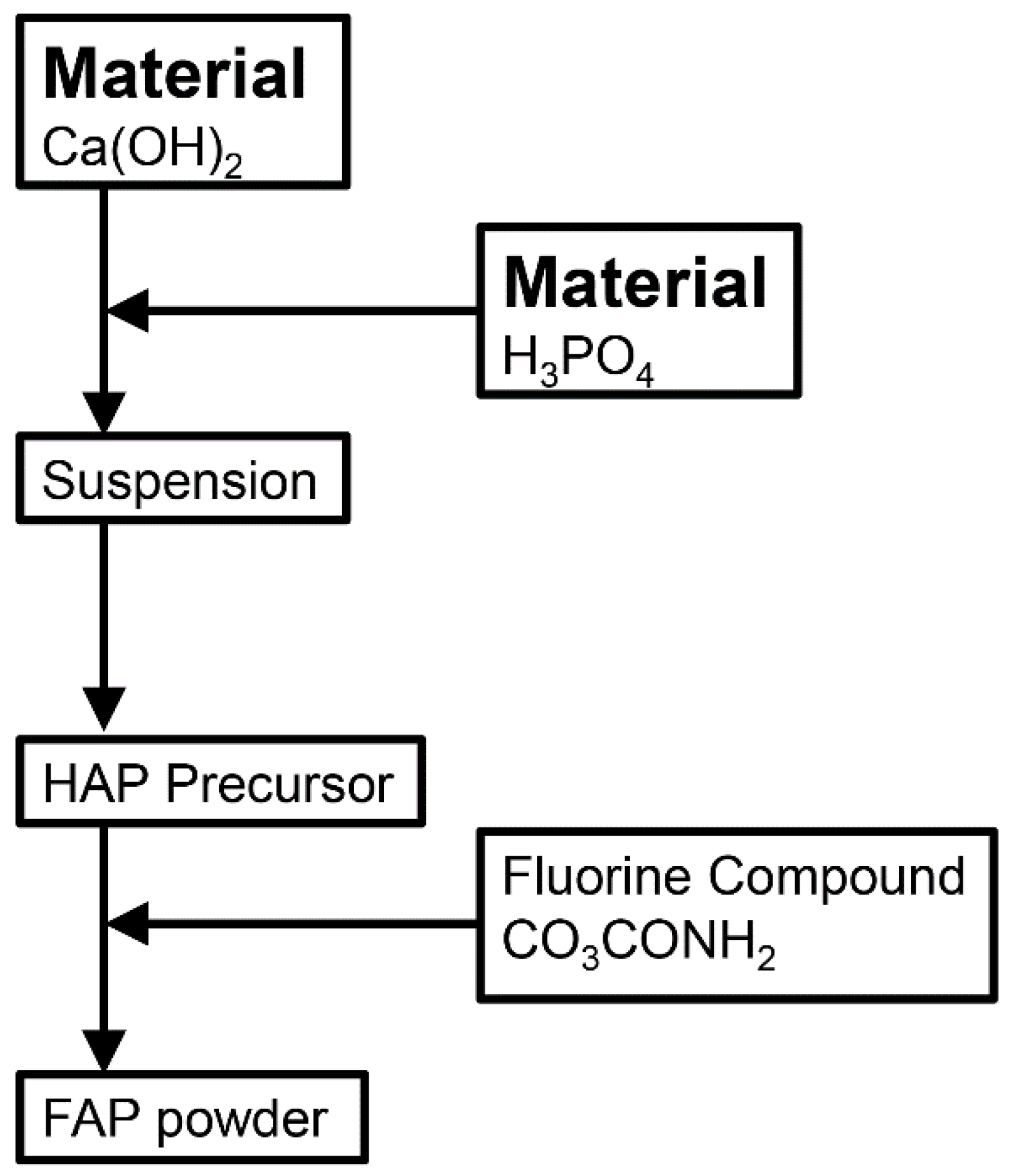
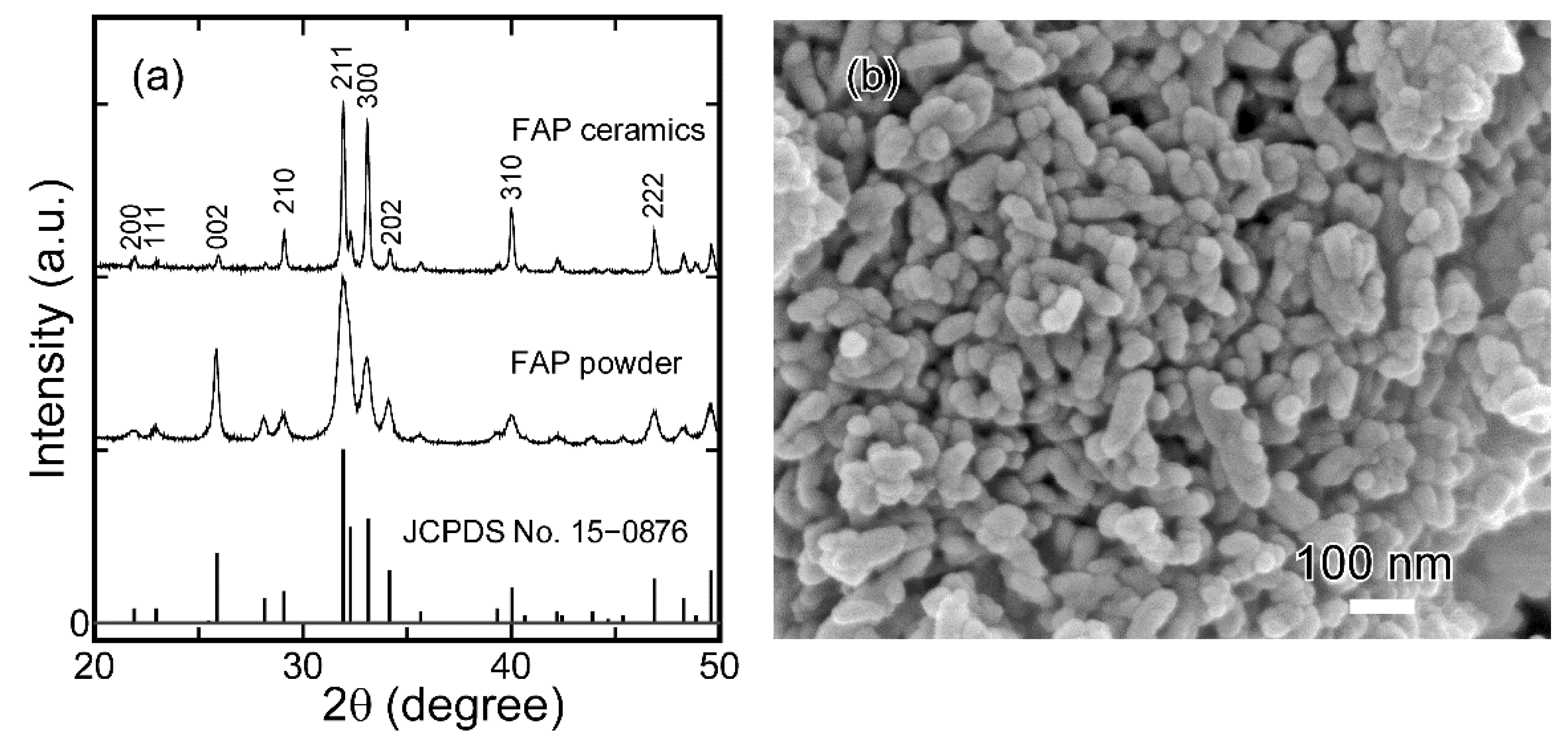
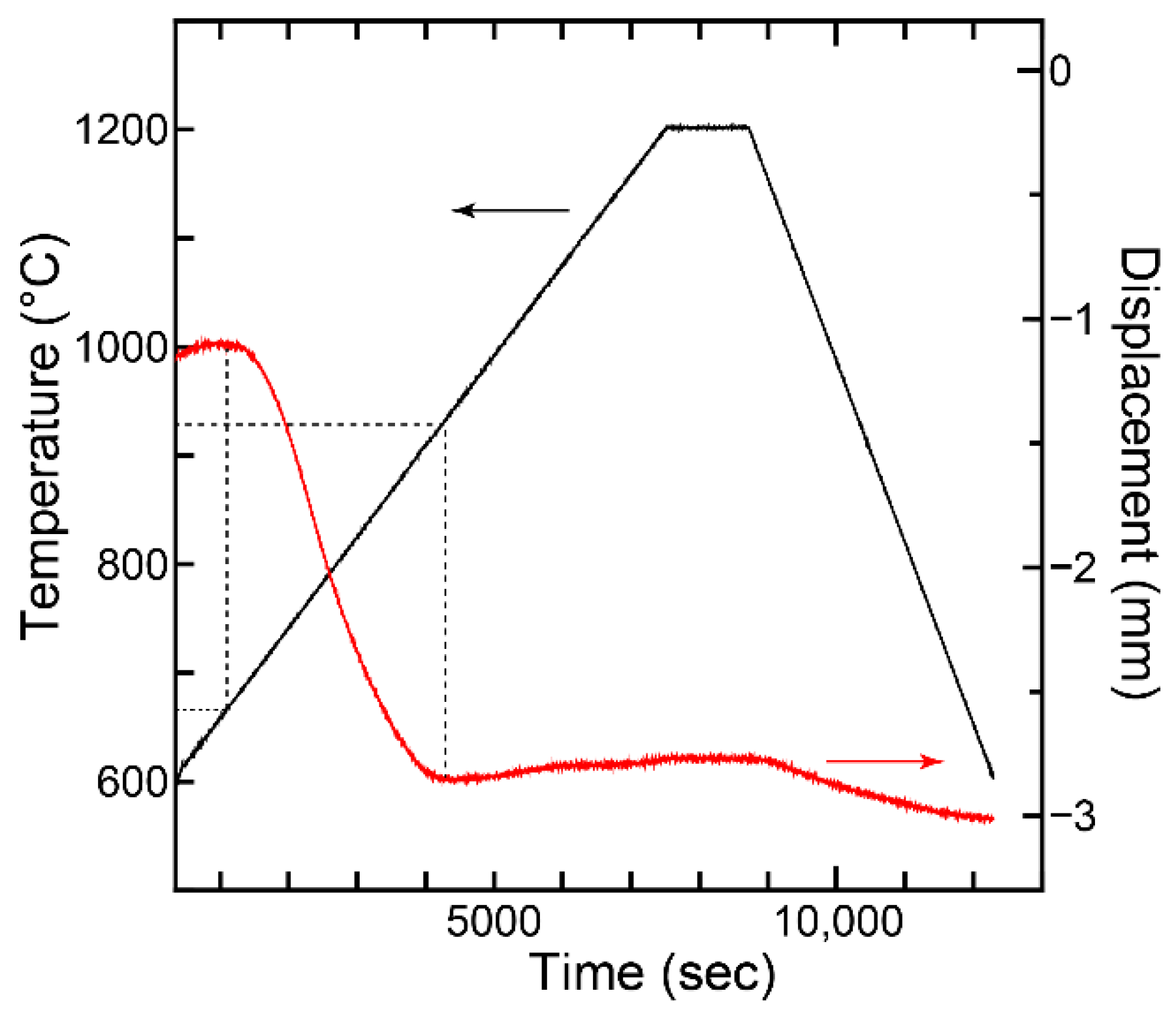


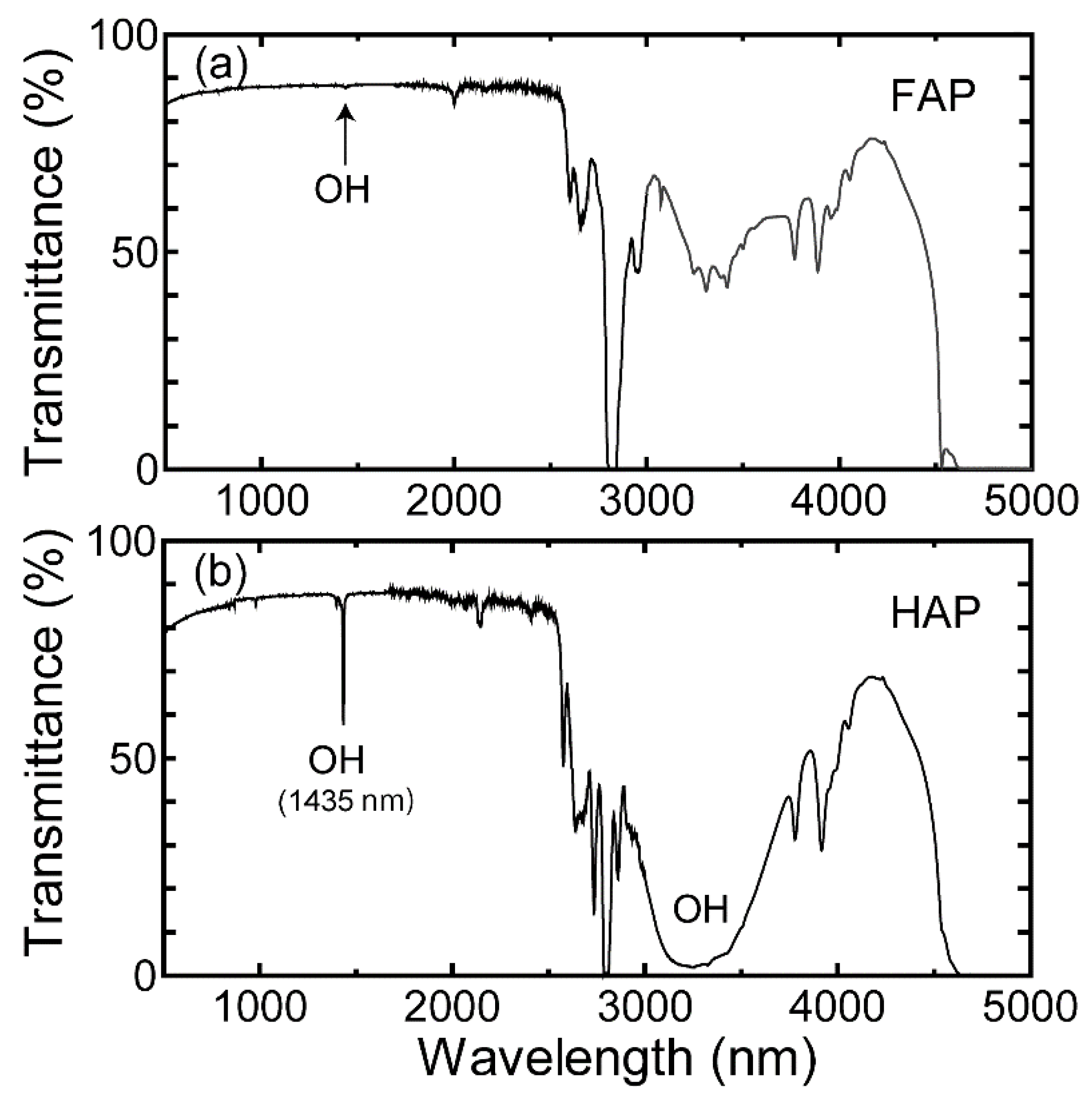
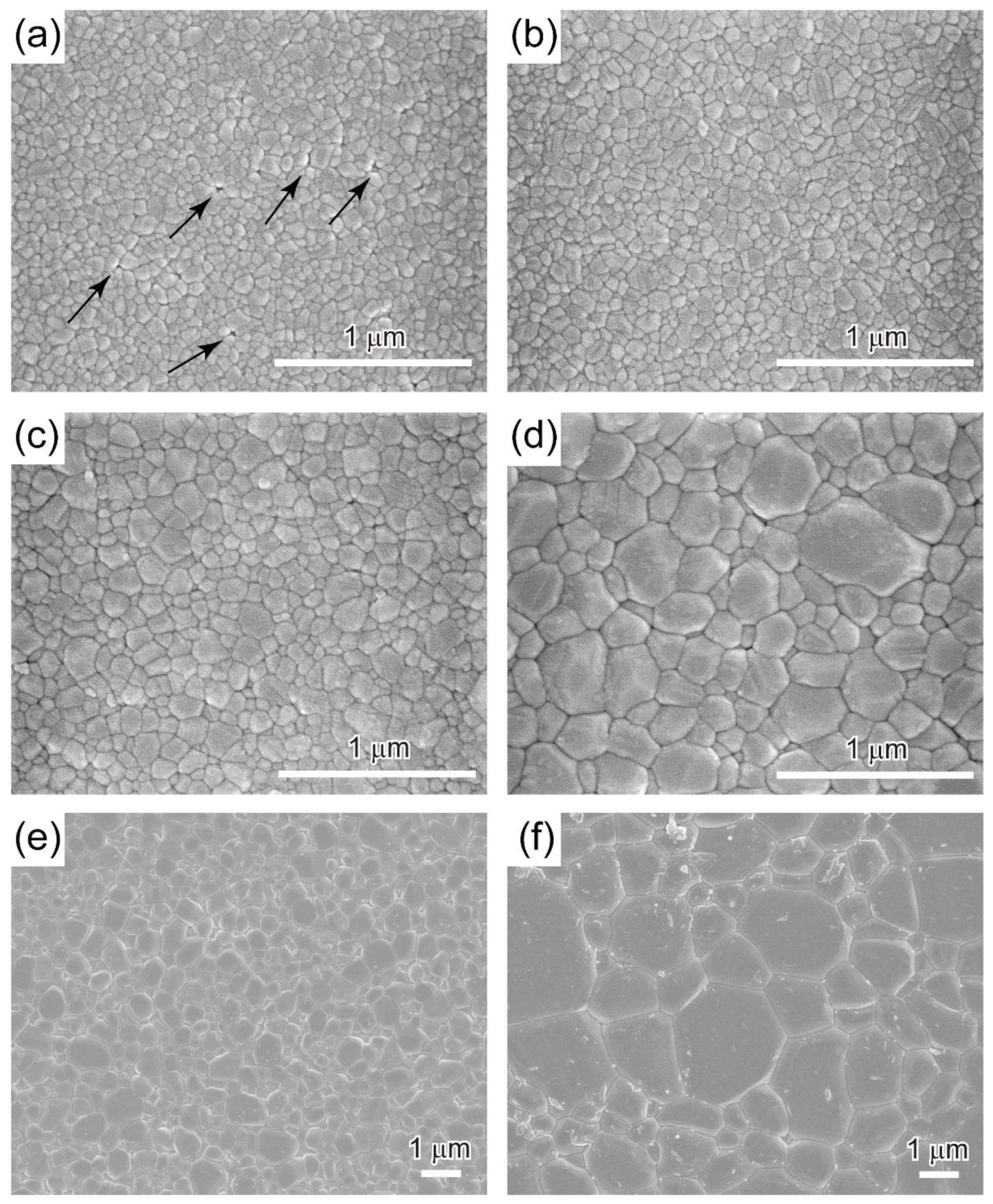
| Sintering Temperature (°C) | In-Line Transmittance at 1000 nm (%) | Average Grain Size (nm) |
|---|---|---|
| 900 | 23.0 | 88 |
| 950 | 86.3 | 101 |
| 1000 | 86.4 | 134 |
| 1050 | 84.0 | 259 |
| 1100 | 86.1 | 528 |
| 1200 | 77.6 | 1644 |
| Host Materials | α (×10−6 K−1) | Κ (W/mK) | σ (MPa) | RT (W/m) | Refs. |
|---|---|---|---|---|---|
| FAP ceramics | 11.5 | 1.3 | 161 | 100 | This work |
| Yb:S-FAP single crystal | 8.4, 9.5 | 2.0 | ~102 | 125 | [12] |
| FAP single crystal | 10.0, 9.4 | 2.1, 1.9 | — | — | [31,32] |
Publisher’s Note: MDPI stays neutral with regard to jurisdictional claims in published maps and institutional affiliations. |
© 2022 by the authors. Licensee MDPI, Basel, Switzerland. This article is an open access article distributed under the terms and conditions of the Creative Commons Attribution (CC BY) license (https://creativecommons.org/licenses/by/4.0/).
Share and Cite
Furuse, H.; Kato, D.; Morita, K.; Suzuki, T.S.; Kim, B.-N. Characterization of Transparent Fluorapatite Ceramics Fabricated by Spark Plasma Sintering. Materials 2022, 15, 8157. https://doi.org/10.3390/ma15228157
Furuse H, Kato D, Morita K, Suzuki TS, Kim B-N. Characterization of Transparent Fluorapatite Ceramics Fabricated by Spark Plasma Sintering. Materials. 2022; 15(22):8157. https://doi.org/10.3390/ma15228157
Chicago/Turabian StyleFuruse, Hiroaki, Daichi Kato, Koji Morita, Tohru S. Suzuki, and Byung-Nam Kim. 2022. "Characterization of Transparent Fluorapatite Ceramics Fabricated by Spark Plasma Sintering" Materials 15, no. 22: 8157. https://doi.org/10.3390/ma15228157
APA StyleFuruse, H., Kato, D., Morita, K., Suzuki, T. S., & Kim, B.-N. (2022). Characterization of Transparent Fluorapatite Ceramics Fabricated by Spark Plasma Sintering. Materials, 15(22), 8157. https://doi.org/10.3390/ma15228157







